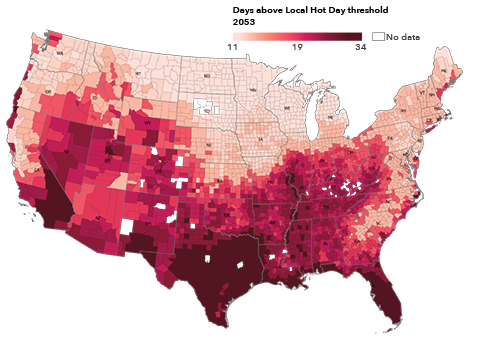What is Florida's future as climate change threats add up?
Hurricanes. Tornadoes. Historic rainfall. Climate change.
If you think Florida has seen it all. Think again, and a recent study on climate risks in the United States confirms some of our worst fears.
It probably comes as no surprise that when you combine the threat of climate change with a state surrounded on three sides by water, Florida doesn't fare well when it comes to a changing climate.
Climate change threat: Climate change is bad for everyone. But this is where it's expected to be worst in the US.
Climate change's impact on weather: What are the causes of climate change? And how can it be stopped?
And did we mention that Florida ties with Louisiana with the second-lowest average elevation, just 100 feet above sea level, on average, according to Statistica. The state with the lowest average elevation is Delaware, at 60 feet above sea level.
“There are no winners in a world where climate change gets worse,” said Adam Kamins, director of regional economics at Moody's Analytics and author of a recent study on climate risks in the United States.
➤ Subscribe to the weekly Climate Point newsletter
➤ Latest climate change news from USA TODAY
Climate change is ramping up the long-term risk almost everywhere, said Kaminss. Temperatures are increasing. Oceans are warming, and rising. And scientists say the heat and higher sea levels help make some natural disasters more extreme.
USA TODAY looked at data from First Street and Moody’s Analytics — two organizations examining future climate risk — to see what areas of the country are most at risk from these climate impacts over the next 30 years.
Here's where Florida stands.
Wind, flooding, sea level rise expected to hit Florida hard
Wind, flooding and sea level rise stack the deck against many counties and states, especially Florida and the Carolinas, Kamins said.
People are still attracted to those locations, but at some point the tide may literally turn against communities along beaches and coastal rivers.
Water everywhere: Florida facing rising sea level, extreme rainfall, intense hurricanes

Florida has 8,346 miles of shoreline.
Rising sea level and extreme rainfall fueled by warming oceans, with the potential for more intense hurricanes while more people crowd into densely populated areas, increase the risks.
➤ Risk Factor: Look up the risks at your address
Florida has the most top spots on First Street's list of counties that could see the biggest increases in the number of days with the very warmest temperatures they experience today.
It's hot and getting hotter: Florida, Texas, Central US could see biggest increase in hot days, new modeling shows
South Florida is forecast to see the biggest increases in the number of very hottest days, according to a new heat model and assessment by the First Street Foundation.
Florida tops the list when it comes to facing the greatest risks
Florida's exposure to hurricanes make it "uniquely susceptible" to physical risk, according to the study, followed by wildfires and floods.
Climate change already is cranking up the rain in some tropical storms and hurricanes and could be slowing them down over land but that research is still underway, scientists say. Floods and wildfires also figured into Kamins’ assessment of physical risks.
Here’s his list of the top five states:
Florida
Louisiana
South Carolina
North Carolina
Delaware
Several Florida cities in top 9 when it comes to gradually increasing risk
Cities facing "chronic physical threat" are those not tied to a single event, but cities facing changes over a longer period. Changes include drought, heat and sea-level rise.
New York City
Long Island, NY
Oakland, CA
Tucson, AZ
Wilmington, DE
North Port, FL
North Carolina cities at risk but 3 Florida cities face threats
Southeastern metropolitan areas are particularly at risk because they’re experiencing rising sea levels and higher temperatures, in addition to a parade of cyclones that could be growing more intense, according to Kamins’ study.
Coastal communities in the Carolinas face the greatest threat, followed by Florida and Puerto Rico.
The top 10:
Jacksonville, NC
New Bern, NC
Myrtle Beach, SC
Wilmington, NC
Greenville, NC
Charleston, SC
Punta Gorda, FL
Deltona, FL
San Juan, PR
Palm Bay, FL
Goldsboro, NC
Will people start moving away from Florida?
It's possible, according to the study.
"Enough disasters will eventually force insurers to abandon markets they deem too risky; this has already happened in some parts of the country, including much of Florida, forcing the public sector to step in.
"That practice, however, will be difficult to sustain and could eventually compel more people to move out of areas that become classified as uninsurable."
Read the full Moody's Analytics report on the impact of climate change on the U.S.
This article originally appeared on Treasure Coast Newspapers: Climate change: Florida tops list facing greatest threat
